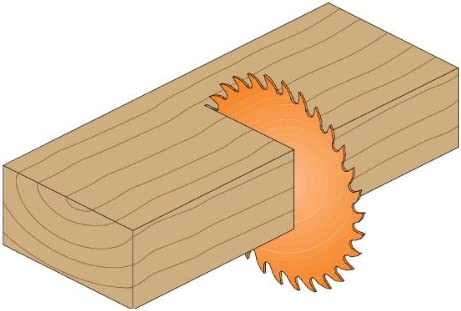Some people find changing the blade of a miter saw intimidating, but it doesn’t have to be. We will lead you through the procedure step by step in this blog article.
We will also share some pointers and strategies to make the process run more smoothly.
So, whether you’re a novice or a seasoned pro, keep reading to learn how to change the blade on your miter saw!

Table of Contents
Reasons to Replace Your Miter Saw Blade
There are various reasons why you might need or want to replace the blade on your miter saw. Some of the causes are as follows:
What causes miter saw damage?
If you hit something while cutting, such as a nail or knot in the wood, or if the blade becomes damaged in any other way, it will need to be replaced. A damaged blade might create severe kickback. It can also cause the saw to cut unevenly.
You may not notice the damage immediately away, but it will become increasingly apparent in the quality of your cuts with time.
It will eventually get to the point when you will have no choice but to replace the blade.
At that point, you might as well just replace it with a higher-quality blade to get better results in the future.
How can I tell if the blade on my miter saw is dull?
The most typical reason for replacing a miter saw blade is that the blade has gotten dull and no longer delivers quality cuts. A dull or unclean blade can cause the saw to bind, produce a backlash, and possibly cause motor damage.
How often should I replace my miter saw blade?
The frequency with which a blade must be replaced is determined by how frequently it is used and the materials it is cutting. If you just cut softwood on occasion, you might be able to get away with changing the blade once a year or so.
However, if you use the miter saw for hours at a time, or if you’re cutting hardwoods or other tougher materials, you’ll need to change the blade more frequently – perhaps every few months.
When inspecting your miter saw blade, pay special attention to the condition of the teeth as well as the carbide. The teeth are the tiny metal blades that cut, and the carbide is a tougher material attached to the tips of the teeth. Here are some things to think about in this regard:
Teeth are harmed
If the teeth are broken or twisted, they must be replaced. If only a few teeth are damaged, you may be able to get away with having only those teeth repaired or replaced. If the majority of the teeth are damaged, it’s time for a new blade.
Carbide Points
You should also look at the carbide tips. These can become chipped or fully broken off, causing harm to both the blade and the workpiece. In most situations, if the carbide tips are destroyed, they cannot be restored, and the entire blade must be replaced.
If your blade bolt is still in good shape but not cutting as well as it once did, you may be able to sharpen it. However, because this needs specialized equipment and training, it is better left to the pros.

The current blade is not cutting cleanly.
If your compound miter saw blade isn’t cutting cleanly, it could be due to a dull blade or one of the following problems:
- Teeth have been destroyed or twisted and must be replaced.
- Carbide tips have been cracked or broken off and must be replaced.
- The blade is dull and should be sharpened.
- Something has been entangled in the blade (for example, a nail) and must be removed.
In most cases, simply checking the blade will reveal which of these flaws is causing the problem. If you’re unsure, though, it’s always advisable to take the saw to a professional for diagnosis.
You Want To Use A Different Blade Size Or Style:
You may need to change the blade on your miter saw in some circumstances if you wish to utilize a different size or style of blade. For example, if you’re chopping firewood, you might want to use a blade with wider teeth because the quality of the cut isn’t as important. When making precise cuts for carpentry, you should use a blade with finer teeth to achieve a more accurate cut.

Quick Guide on Changing Miter Saw Blades:
Whatever the reason, changing the blade on your miter saw is a reasonably straightforward and easy task that anyone with a few tools and the right instructions can complete.
Tools Needed:
- Wrench for blades
- Brand new blade
- Goggles for safety
- Hearing protection is essential.
Step 1: Turn off the Miter Saw.
Before you begin, make sure to put on gloves and unplug the saw. This is a critical safety measure that should never be overlooked while changing the blade.
Step2: Raise The Blade Guard
Next, lift the miter saw blade guard as far as it will go using the blade adjustment knob. This will offer you more room to work and make removing the old blade easier.
You may need to remove the dust bag from your saw before you can raise the blade. For details on how to accomplish this, refer to your owner’s handbook.
Step 3: Discard the old miter saw blade.
After raising the blade, use the blade wrench to release the bolt cover that holds the blade in place. Most bolts must be removed by turning them counterclockwise.
You should be able to slip the old blade off the arbor after loosening the bolt cover. If it becomes stuck, gently tap it with a hammer until the bolt cover comes off.
Step 4: Replace the blade
Simply put the new miter saw blade onto the arbor and tighten down the bolt. To tighten the bolt, you’ll normally need to turn it clockwise. Once tight, return the blade to its original place.
If your saw has a dust bag, you must replace it now.
Step 5: Put the New Blade to the Test
Before you begin cutting, always test the new blade to ensure it is firmly inserted in the spindle cover and working well. Simply turn on the saw and let it run for a few seconds to do this. If everything seems and sounds normal, you can begin cutting.
If something doesn’t look right, turn the saw off and double-check that the saw blade is properly inserted. When you’re certain that everything is in order, restart the saw’s blade washer.
Conclusion:
It’s as simple as that! As you can see, changing the miter saw blades is a rather straightforward process that anyone can perform.

